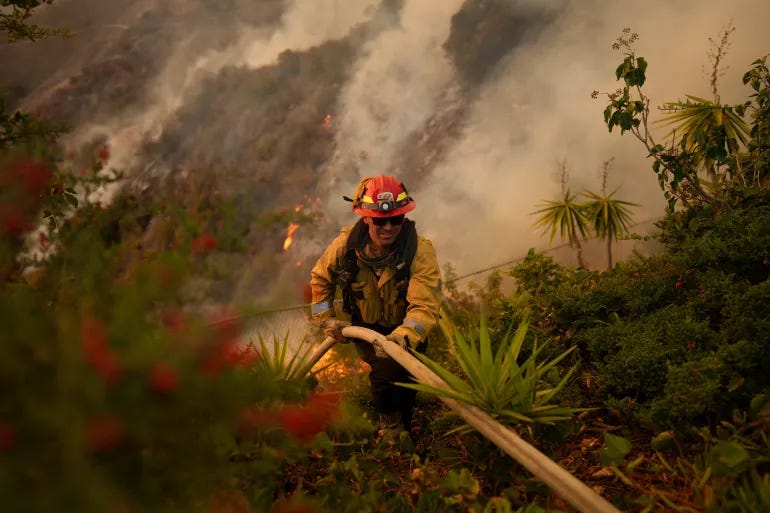Inmates Play Key Role in Fighting Los Angeles Wildfires Amid Global Assistance
As California’s prison inmates join firefighting crews, international aid flows in to tackle the devastating blazes.
Amid the raging wildfires that have torn through Los Angeles, leaving 24 people dead and thousands of acres scorched since January 7, California prison inmates have become an essential part of the firefighting response. With two major fires, the Palisades and Eaton blazes, continuing to threaten the region, the state has enlisted nearly 950 inmates to assist fire crews in their efforts to contain the inferno.
The fires, fueled by dry Santa Ana winds, have already burned through nearly 40,000 acres (15,300 hectares) and destroyed over 12,000 structures. With at least 16 people still missing and over 100,000 people evacuated, the urgency to control the fires remains high.
Why Are Inmates Being Deployed?
California’s inmate firefighting program, established in 1915, has long relied on prisoners to help with wildfire suppression efforts. These inmates, wearing distinctive orange uniforms, do not engage in direct firefighting with hoses or water. Instead, they use hand tools to clear brush and assist emergency workers, playing a crucial role in reducing fire spread.
For each day they work, inmates have two days shaved off their sentences, according to the state’s Department of Corrections and Rehabilitation. Additionally, this work can offer inmates job opportunities upon release, such as advanced training in firefighting and the possibility of having their criminal records expunged. However, critics argue that despite this, many ex-inmates struggle to find employment due to their criminal past.
Controversy Over Inmate Labor
While California has relied on inmate firefighters for over a century, the practice has faced criticism. Inmates are paid a meager $10.24 per day, far below the state’s minimum wage of $16.50 an hour. This low pay for dangerous and grueling work has sparked debate, especially after a 2022 report revealed that four prisoner firefighters had been killed and over 1,000 injured while working in California’s fire response efforts.
National and International Support for California
As California’s wildfire season intensifies, firefighters from other U.S. states, as well as international crews, have arrived to help. Nearly 14,000 fire personnel are now working across the region, supported by 1,400 fire engines and 84 aircraft.
Canada and Mexico have contributed significantly to the firefighting efforts. More than 70 Mexican firefighters arrived in Los Angeles on Saturday, and 60 Canadian firefighters are scheduled to deploy by Monday. Ukraine has also pledged support, with 150 Ukrainian firefighters ready for deployment.
Meanwhile, wealthy property owners in high-risk areas have been hiring private fire crews at great expense to protect their properties.
Challenges in Fighting the Fires
With the wildfire season in full force, Los Angeles faces a grave situation. The National Weather Service has issued red flag warnings due to critical fire conditions, with sustained winds of up to 50 mph (80 km/h) and gusts reaching 70 mph (113 km/h) in mountainous areas. Fire behavior analysts predict Tuesday will present the greatest risk.
In preparation, Los Angeles Fire Chief Anthony C. Marrone announced the deployment of 70 additional water trucks, and officials have been working to deploy fire retardants to protect hillside communities from further destruction.
Future of Wildfire Management
As California grapples with some of the most devastating wildfires in its history, political figures have begun to point fingers. Governor Gavin Newsom has called for an investigation into the causes of the crisis, particularly focusing on why critical infrastructure like a 117-million-gallon reservoir in Pacific Palisades was non-operational during the fires.
The lack of water at some fire hydrants during the crisis has also drawn criticism from Los Angeles Fire Chief Kristin Crowley, who stressed the importance of adequate funding and preparedness to combat future fires.
As California confronts an estimated economic loss of $135-150 billion from the wildfires, the state is working with both local and international partners to bolster firefighting efforts and address the underlying challenges that have made these fires so destructive.


